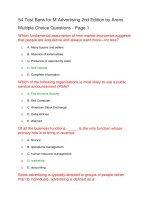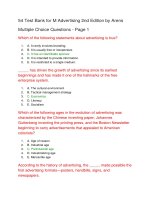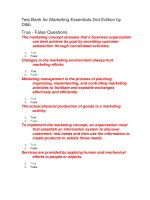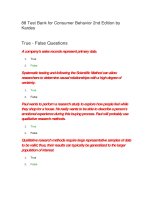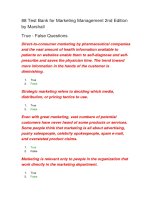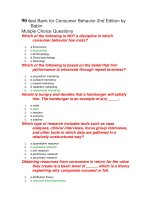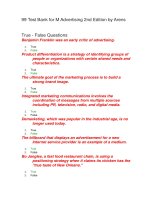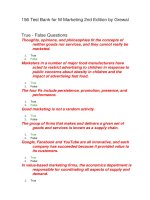Macroeconomics for life smart choices for all canadian 2nd edition by cohen solution manual
Bạn đang xem bản rút gọn của tài liệu. Xem và tải ngay bản đầy đủ của tài liệu tại đây (3.49 MB, 45 trang )
Macroeconomics for Life Smart Choices for All Canadian 2nd
edition by Cohen Solution Manual
Link full download solution manual: />
2. Making Smart Choices
The Law of Demand
Learning Objectives
1.
Describe what determines your willingness and ability to pay for a product or service.
2.
Identify why smart choices depend on marginal benefits, not total benefits, and explain what changes marginal benefits.
3.
Explain the law of demand, and describe the roles of substitutes and willingness and ability to pay.
4.
Explain the difference between a change in quantity demanded and a change in demand, and identify five factors
that change demand.
Lecture Narrative
This chapter explains demand as a response to two questions: “How badly do you want it?” and “How much are you
willing and able to give up for it?” Demands are smart choices when expected benefits are greater than costs, and I
emphasize the importance of marginal benefit (Key 2). I develop quantity demanded and the law of demand from
examples of choices among substitutes, focusing on what happens to buying decisions when prices change. To help
students understand the importance of marginal benefit for smart choices, I illustrate the two ways to read a demand
curve. Reading from price to quantity (over and down), highlights the effects of substitution. Reading from quantity to
marginal benefit (up and over), highlights willingness and ability to pay at the margin.
The final section on the five factors that change demand (including substitutes, complements, and normal/inferior goods)
begins with an apparent contradiction to the law of demand, when gas prices rise and the quantity of gasoline bought and
sold increases. This motivates the distinction between a change in quantity demanded and a change in demand, which allows
us to “save” the law of demand from the apparent contradiction. Because there are no further chapters on consumer choice,
this chapter contains all of the intuition behind consumers’ willingness and ability to pay for products and services.
Graphs, Tables and Illustrations
Figure Title
2.1 Your Demand for Beats Headphones
2.2 Market Demand for Water
2.3 Two Ways to Read a Demand Curve
a) Reading the Demand Curve as a Demand Curve
b) Reading the Demand Curve as a Marginal Benefit Curve
G, I, T
Page
T
34
T, G
35
G
36
G
2.4 An Increase in Demand for Beats Headphones
T, G
40
2.5 More Consumers Increase the Market Demand for Water
T, G
44
2.6 Change in Quantity Demanded versus a Change in Demand
a) Change in Quantity Demanded
b) Change in Demand
G
G
45
2.7 Law of Demand and Changes in Demand
T
46
Key:
G - Graph(s)
For titles in blue, Narrated Dynamic Graph videos are available online on each Chapter Resources page.
T - Table
Graphs follow on the next page.
Narrated Dynamic Graphs are identified with a blue video button. To access them, log into the Pearson course
website (pearsonmylab.com), click on Chapter Resources, and then Chapter 2.
13
MACROECONOMICS FOR LIFE INSTRUCTOR’S MANUAL
CHAPTER 2: THE LAW OF DEMAND
www.economicsforlife.ca
Market Demand for Water
Pric
e
2.2
$3.50
E
$3.00
D
$2.50
C
$2.00
B
$1.50
A
$1.00
Market Demand Curve
$0.50
0
1
2
3
4
5
6
7
Quantity
2.3b
2.3a Reading the Demand Curve as a Demand Curve
Reading the Demand Curve as a
Marginal Benefit Curve
Price
E
$3.00
D
$2.50
C
$0.50
1000
0
$1.50
A
$1.00
Demand for Water
B
From any quantity on the
horizontal axis, go up to the
A
marginal bene t curve and
Marginal Benefit of
over to the price.
Water
$0.50
3000
4000
An Increase in Demand for Beats Headphones
5000
Quantity
0
2.5
1000
2000
3000
4000
5000
Quantity
More Consumers Increase the Market
Demand for Water
Pr
ic
e
Price
2.4
2000
C
$2.00
B
From any price on the
vertical axis, go over
to the demand curve
and down to the
quantity demanded.
$1.00
D
$2.50
$2.00
$1.50
E
$3.00
$3.00
$300
$2.50
$2.00
$200
$1.50
D0
D1
$1.00
$100
D0
$0.50
0
14
1
2
3
Quantity
MACROECONOMICS FOR LIFE INSTRUCTOR’S MANUAL
www.economicsforlife.ca
0
1
2
3
4
5
6
7
8
Q
CHAPTER 2: THE LAW OF DEMAND
Change in Quantity Demanded
Price
2.6a
Change in Demand
Increase in demand is
rightward shi of demand
curve.
Price
2.6a
Increase in quantity
demanded is a movement
down along an unchanged
demand curve.
Decrease in quantity
demanded is a movement
up along an unchanged
demand curve.
Decrease in
demand is
le ward shi
of demand
D
2
curve.
D
0
D
D0
1
Quantity
Quantity
Active Learning Suggestions
Top Choice
The best way to introduce the law of demand is to hold a real auction in class. I bring something students like (a Coke on a Pepsionly campus, cookies from the bakery where my daughter works, ….) and start playing promoter, selling a wonderful
(ice-cold Coke! Cookies made with real ginger!) product. The rules are that I put prices on the board, starting at $0, and ask
students who are willing and able to pay that price to raise their hands. Then I count (very roughly in large classes) the
number of hands and write that quantity next to the price. The key rule is that students must have the cash (no debit or VISA)
and must buy the product if they are the highest bidder. I usually start with 50 cent increments, but use my judgment about
jumping to larger increments. What appears on the board is the inverse relation between price and quantity demanded. At
prices get really high, this often turns into a “pissing contest” between a few student who want to win and come up to the
front of the class to claim their prize, and the number of hands can increase at the highest prices.
After the fun and shouting (the more the better) subside (you should do your best imitation of a game show host), the
teaching part of the activity comes from asking students what factors went into their decisions, at each price, to raise their
hand or not. From their answers, you get all of the assumptions behind the law of demand. One important answer that
always emerges is that the quantity demanded drops off dramatically as you pass the price most students think the product
sells for elsewhere. This emphasizes the importance of substitutes for the law of demand. Even the bidding at the end that
violates the law of demand allows discussion of status goods (see Refresh question 2.4.3).
Come prepared with lots of change, and let students know you are donating the money to a scholarship fund or
student association at your school. I have sold a Coke for $20 and a box of 6 cookies for $50!
Dynamic
Study Modules
Teaching Blog
15
The online Dynamic Study Modules ( />dynamic_study_modules.html) are created generically for any Canadian economics text. Modules students can work
through with some (not all) content related to Chapter 2:
•
The Market Forces of Supply and Demand
•
The Theory of Consumer Choice
•
The Basis of Consumer Behaviour
Check out economicsforlife.ca for new media stories, related discussion questions, and other active learning ideas.
All posts are tagged by textbook chapters and topics.
MACROECONOMICS FOR LIFE INSTRUCTOR’S MANUAL
www.economicsforlife.ca
CHAPTER 2: THE LAW OF DEMAND
Put Your Money Where Your Mouth Is:
Weighing Benefits, Costs, and Substitutes
2.1
Learning Objective
Describe what determines your willingness and ability to pay for a product or service.
Your willingness to buy a product or service depends on your ability to pay, comparative benefits and costs,
Main Point
and the availability of substitutes.
Key Terms
Preferences
your wants and their intensities
Demand
consumers’ willingness and ability to pay for a particular product or service
Discussion or Homework Q&A
1.
Q.What is a smart choice?
A.•when making a decision consider only additional (marginal) costs and additional (marginal) benefits
•
all the sunk costs are ignored
•
a smart choice is very important when facing scarcity
2.
Q.If you don’t have enough money to get a product, can you still have a demand for it?
A.
•
•
•
no
demand is a willingness and ability to pay
if you can’t pay, your willingness alone does not count
Refresh Q&A
2.1.1
2.1.2
2.1.3
Q.
What is the difference between wants and demands?
A.
Wants are much greater than demands. Your wants for products or services are limitless, and economists describe your
wants and their intensities as your preferences. Demand describes your willingness and ability to pay for a particular
product or service. You must put your money (or time) where your mouth is in order to demand a product or service.
Q.
What is the key factor that would make you choose to download a song for free rather than pay for it on iTunes? Explain
your choice.
A.
Answers will differ, but whatever the students’ personal decision between buying music and downloading music for free,
some factors that are likely to influence their choice are:
how much they like the song (their preferences and expected benefits from listening)
•
whether the song is available for free
•
how much it costs to buy
•
what they can afford to pay
•
their values about the ethics of downloading
•
Q.
You have just started at a school that is a 30-minute drive from home or a 90-minute transit ride. What is your smart
choice, taking the transit or buying a car? Justify your choice.
In making the choice between transit or buying a car, you should determine what the marginal benefits will be and if
A.
they are greater than the costs.
In choosing between taking transit to school or driving, the benefits comparison includes:
•
the convenience and speed of driving versus the fixed transit schedule and longer ride
•
how much you value your time
•
the costs of owning and driving a car versus transit fares
If you are concerned about the environment, you might also consider the environmental advantages of public transit
in making your choices.
16
MACROECONOMICS FOR LIFE INSTRUCTOR’S MANUAL
www.economicsforlife.ca
CHAPTER 2: THE LAW OF DEMAND
Living on the Edge:
Smart Choices are Marginal Choices
2.2
Learning Objective
Identify why smart choices depend on marginal benefits, not total benefits, and explain what changes marginal benefits.
Main Point
Key 2 states, ―Count only additional benefits and additional costs.‖ Additional benefits mean marginal
benefits — not total benefits — and marginal benefits change with circumstances.
Key Term
Marginal benefit
the additional benefit from a choice, changing with circumstances
Discussion or Homework Q& A
1.
Q.Consider the diamond/water paradox — diamonds are very expensive but not required for life, but water, a necessity
for life, is relatively inexpensive. What if you are Bill Gates walking through the desert alone with pockets full of
diamonds? How will this affect your marginal benefits?
A.
Water is scarce in the desert, so its marginal benefit is very high while having pockets full of diamonds makes their
marginal benefit low. In this situation, the price of water may exceed the price of diamonds.
2.
Q.A demand curve shows visually the relationship between two variables – price and quantity demanded. Explain what
it means to ―read‖ this relationship in two ways.
A.
There are correlations between the two variables. Reading two ways is to attach different causation stories to the
relationship. The demand curve story tells for any price, what quantities consumers will demand. The marginal benefit
story tells for any quantity, how much someone is willing to pay.
Refresh Q&A
2.2.1
2.2.2
2.2.3
17
Q.
In your own words, define marginal benefit.
A.
Answers may vary but should include the following concepts. Marginal benefit is the additional benefit from a choice.
Marginal benefit changes with circumstances. For example, the additional benefit you get from studying for one more hour
depends on if you have hardly studied at all (marginal benefit will then be high) or if you have studied your brains out
already (marginal benefit will then be low).
Q.
Explain why we are willing to pay more for a diamond than a glass of water even though water is essential for survival
and diamonds are an unnecessary luxury.
A.
The difference in willingness to pay more for a diamond than a glass of water is connected to the difference between
marginal benefit and total benefit. Willingness to pay depends on marginal benefit, not total benefit. Because water is
abundant, the marginal benefit of an additional glass of water is low, even though the total benefit of all water consumed,
including the first lifesaving glass, is high. Because diamonds are scarce, marginal benefit is high, even though total benef it
of the few diamonds available is low.
Q.
You and your entrepreneurial buddy have a concession stand on the beach. It is a hot, sunny, crowded day, and you are
selling a few $5 collapsible umbrellas as sun shades. The skies suddenly darken, rain begins to pour, and your buddy
quickly switches the umbrella price sign to $10. Will you sell more or fewer umbrellas? Explain your thinking, including
your analysis of the customer’s decision.
A.
Even though you raise the price of umbrellas from $5 to $10, you might still sell more umbrellas as it starts raining. The rain
dramatically increases the marginal benefit of an umbrella to customers, so they might still be making a smart choice to
buy an umbrella, even at the $10 price. Two factors for consumers’ choices have changed — increased cost (leading to fewer
sales) and increased benefits (leading to higher sales) — so it is hard to predict if you will sell more or fewer umbrellas.
MACROECONOMICS FOR LIFE INSTRUCTOR’S MANUAL
www.economicsforlife.ca
CHAPTER 2: THE LAW OF DEMAND
Move on When the Price Isn’t Right:
The Law of Demand
2.3
Learning Objective
Explain the law of demand and describe the roles of substitutes and willingness and ability to pay.
Main Point
The demand curve combines two forces — switch to substitutes; willingness and ability to pay — determining
quantity demanded, and can be read as a demand curve and as a marginal benefit curve.
Key Terms
Quantity demanded
the amount you actually plan to buy at a given price
Market demand
the sum of demands of all individuals willing and able to buy a particular product or service
Law of demand
if the price of a product or service rises, quantity demanded decreases, other things remaining the same
Demand curve
shows the relationship between price and quantity demanded, other things remaining the same
Discussion or Homework Q&A
1.
Q.Advertising is designed to increase your preference for a product or service. Give an example of a slogan that changed
or shaped your preference.
A.
•“There’s always Coca-Cola” (you should keep on having colas)
•
“You’ve always got time for Tim Hortons” (go out of your way but come to the doughnut shop)
•
“Harveys: Have it your way” (have a customized burger every time)
2.
Q.Suppose a city is considering the idea of returning to a flat monthly rate payment scheme for water usage instead of
its current fee for use structure. Explain what will happen to the demand for the following products: water,
orange juice, soap, rubber ducky bath toys.
A.
Water: quantity demanded will increase because price has fallen
Orange juice: demand will decrease because, water, a substitute good, is now cheaper
Soap: demand will increase because water, a complement good, is now cheaper. Longer showers!
Rubber ducky bath toys: demand will increase because it is a complement good
Refresh Q&A
2.3.1
2.3.2
Q.
In just a couple of sentences, explain the law of demand to a friend who is not taking this economics course.
A.
Answers may differ, but should include all or most of the following:
If the price of a product or service rises, quantity demanded decreases.
•
At a higher price, fewer consumers are willing and able to pay for the product or service.
•
Some consumers switch to cheaper substitutes as prices rise.
•
Q.
You own a car and work at a job that you cannot get to by public transit. If the price of gasoline goes up dramatically,
does the law of demand apply to you? Explain the choices you might make in responding to this price rise.
A.
As the price of gasoline goes up, your commute to work becomes more expensive. Although public transit is not available as
a substitute, there are still choices you can make to reduce the quantity demanded of gasoline. You might arrange a carpool
with other employees, which would reduce the total quantity demanded of gasoline. You might also keep your car tuned
up to save gas, or turn off the engine instead of idling. With more time to adjust, you might move closer to this job, find a
different job that is closer to home or accessible by transit, or buy a hybrid or more fuel-efficient car. All of these choices will
decrease your quantity demanded of gasoline.
More questions follow on the next page.
18
MACROECONOMICS FOR LIFE INSTRUCTOR’S MANUAL
www.economicsforlife.ca
CHAPTER 2: THE LAW OF DEMAND
Refresh Q&A (continued)
2.3.3
19
Q.
You have tickets for a concert tonight that you have been looking forward to. Your mother, who is helping you pay your
tuition, phones and says that it’s very important to her that you come to Grandma’s birthday party tonight. Using the law
of demand, explain your decision — the concert or Grandma’s party? [Hint: Think about opportunity cost]
A.
According to the law of demand, as the price rises, quantity demanded decreases. The “price” of going to the concert
includes the ticket price, but also includes the opportunity cost of what you give up to attend the concert. Your mother’s
request to come to Grandma’s birthday party increases the opportunity cost of going to the concert. As the concert “price”
rises, your choice to go to the party decreases your quantity demanded of concert tickets from 1 to 0.
MACROECONOMICS FOR LIFE INSTRUCTOR’S MANUAL
www.economicsforlife.ca
CHAPTER 2: THE LAW OF DEMAND
Moving the Margins:
What Can Change Demand?
2.4
Learning Objective
Explain the difference between a change in quantity demanded and a change in demand, and identify five factors that
change demand.
Main Point
Quantity demanded is changed only by a change in price. Demand is changed by all other influences on consumer choice.
Key Terms
Increase in demand
increase in consumers’ willingness and ability to pay. Rightward shift of demand curve.
Decrease in demand
decrease in consumers’ willingness and ability to pay. Leftward shift of demand curve.
Substitutes
products or services used in place of each other to satisfy the same want
Complements
products or services used together to satisfy the same want
Normal goods
products or services you buy more of when your income increases
Inferior goods
products or services you buy less of when your income increases
Discussion or Homework Q&A
1.
Q.Identify the factor responsible for changing demand – i.e. preferences, prices of related goods, income, expected future
prices or the number of consumers – after the following events take place:
a. The impact on the demand for groceries at a local store after a new 120-unit apartment building is built.
b. The impact of downloading music on the demand for CDs.
c. The impact on the demand for cars and houses in anticipation of a 1% decrease in GST.
d. A popular band’s last year’s album that became a bestseller can suddenly be found in a discount bin at the
music store for only $1.99.
A.
a. number of consumers
b. prices of related goods
c. expected future prices
d. preferences
2.
Q.Young drivers account for more than 35% of all drivers involved in fatal accidents, despite only representing 20% of
all licensed drivers. Explain how each of the following policies would affect the demand for alcohol:
a. increasing the minimum age for drinking
b. raising the price (e.g. through higher taxes) of alcohol
c. using advertising campaigns to deter alcohol usage
A.
a. decrease demand
b. decrease in quantity demanded
c. decrease demand
Refresh Q&A
2.4.1
20
Q.
Explain the difference between a change in quantity demanded and a change in demand. Identify the five factors that can
change demand.
A.
A change in the quantity demanded of a product or service is due to a change in the price of that product or service.
A change in demand for a product or service is caused by a change in anything else. The five (“anything else”) factors that
can change market demand are changes in preferences, prices of related products, income, expected future prices, and
number of consumers.
MACROECONOMICS FOR LIFE INSTRUCTOR’S MANUAL
www.economicsforlife.ca
CHAPTER 2: THE LAW OF DEMAND
Refresh Q&A (continued)
2.4.2
2.4.3
Q.
Roses sell for about $40 a bouquet most of the year, and worldwide sales are 6 million bouquets per month. Every
February, the price of roses doubles to $80 a bouquet, but the quantity of roses demanded and sold also increases, to 24
million bouquets per month. The cost of producing roses doesn’t change throughout the year. Can you explain what else
is going on that saves the law of demand?
A.
A rise in price decreases quantity demanded, as long as other factors besides price do not change. The key “other factor” that
changes in February is Valentine’s Day. Because of the Valentine’s Day tradition of giving roses as gifts, preferences for roses
increase (a greater willingness to pay for roses) in February. It is this increase in preferences that saves the law of demand
and accounts for the increase in sales of roses even though the price of roses is higher.
Q.
There are some ―status goods,‖ like Rolex watches, that people want to own because they are expensive. In contradiction
to the law of demand, if Rolex watches were less expensive, few ―status-seeking‖ consumers would demand them.
Reconcile status products or services with the law of demand. How does the existence of cheap ―knock-off‖ imitations of
Rolex watches fit with the law of demand?
A.
Consumers who demand “status goods” like Rolex watches are mostly demanding the status of appearing able to afford the
expensive watch, rather than the time-keeping qualities of the watch itself. A cheap, non-Rolex watch is not a substitute for a
status-seeking consumer. But knockoff Rolex watches illustrate the law of demand for status goods. As long as the consumer
believes that others cannot tell the difference between a real Rolex and a knockoff, the knockoff supplies the same status at a
lower price. The fact that more knockoffs are sold than real Rolex watches illustrates the law of demand for status goods.
21
MACROECONOMICS FOR LIFE INSTRUCTOR’S MANUAL
www.economicsforlife.ca
CHAPTER 2: THE LAW OF DEMAND
Primary Deck
© 2015 Pearson Canada Inc. Chapter 2 Slide 1
WEIGHING BENEFITS, COSTS & SUBSTITUTES
Your willingness to buy a product or
service depends on your ability to pay,
comparative benefits and costs, and the
availability of substitutes.
© 2015 Pearson Canada Inc. Chapter 2 Slide 2
WEIGHING BENEFITS, COSTS & SUBSTITUTES
• Preferences
your wants and their intensities
• Demand
consumers’ willingness and ability to pay for
a particular product or service
• For any choice, what you are willing to pay or give
up depends on
– Cost
– Availability of substitutes
© 2015 Pearson Canada Inc. Chapter 2 Slide 3
SMART CHOICES ARE MARGINAL CHOICES
Key 2 states, “Count only additional benefits and
additional costs.” Additional benefits mean
marginal benefits – not total benefits – and
marginal benefits change the circumstances.
© 2015 Pearson Canada Inc. Chapter 2 Slide 4
SMART CHOICES ARE MARGINAL CHOICES
• Marginal benefit
– Additional benefit from a choice
– Changing with circumstances
• Marginal benefit explains the diamond/water
paradox
– Willingness to pay depends on marginal benefit,
not total benefit
– Water is abundant, marginal benefit is low
– Diamonds are scarce, marginal benefit is high
© 2015 Pearson Canada Inc. Chapter 2 Slide 5
THE LAW OF DEMAND
The demand curve combines two forces –
switch to substitutes; willingness and ability to pay –
determining quantity demanded, and can be read
as a demand curve and as a marginal benefit curve.
© 2015 Pearson Canada Inc. Chapter 2 Slide 6
THE LAW OF DEMAND
• Quantity demanded
the amount you actually plan to buy at a given
price
• Market demand
the sum of demands of all individuals willing and
able to buy a particular product or service
• Law of demand
if the price of a product or service rises, quantity
demanded decreases, other things remaining
the same
• Demand curve
shows the relationship between price and
quantity demanded, other things remaining the
© 2015 PearsameonCanada Inc. Chapter 2 Slide 7
Fig. 2.2 Market Demand for Water
© 2015 Pearson Canada Inc. Chapter 2 Slide 8
Fig. 2.3a
Two Ways to Read a Demand Curve:
© 2015 Pearson Canada Inc. Chapter 2 Slide 9
Two Ways to Read a Demand Curve:
Fig. 2.3b
Marginal Benefit Curve – Read Up and Over
© 2015 Pearson Canada Inc. Chapter 2 Slide 10
WHAT CAN CHANGE DEMAND?
Quantity demanded changes only with a
change in price. All other influences on
consumer choice change demand.
© 2015 Pearson Canada Inc. Chapter 2 Slide 11
WHAT CAN CHANGE DEMAND?
• Demand is a catch-all term summarizing all
possible influences on consumers’ willingness and
ability to pay for a particular product or service
– Increase in demand
increase in consumers’ willingness and ability
to pay. Rightward shift of demand curve.
– Decrease in demand
decrease in consumers’ willingness and
ability to pay. Leftward shift of demand curve.
© 2015 Pearson Canada Inc. Chapter 2 Slide 12
• Demand changes with changes in preferences,
prices of related goods, income, expected future
price, and number of consumers. For example,
demand increases with
– Increase in preferences
– Rise in price of a substitute
products or services used in place of each
other to satisfy the same want
– Fall in price of a complement
products or services used together to satisfy
the same want
© 2015 Pearson Canada Inc. Chapter 2 Slide 13
– Increase in income for normal goods products
or services you buy more of when your income
increases
– Decrease in income for inferior goods products
or services you buy less of when your income
increases
– Rise in expected future prices
– Increase in number of consumers
© 2015 Pearson Canada Inc. Chapter 2 Slide 14
Fig. 2.4
An Increase in Demand for Beats
Headphones
© 2015 Pearson Canada Inc. Chapter 2 Slide 15
